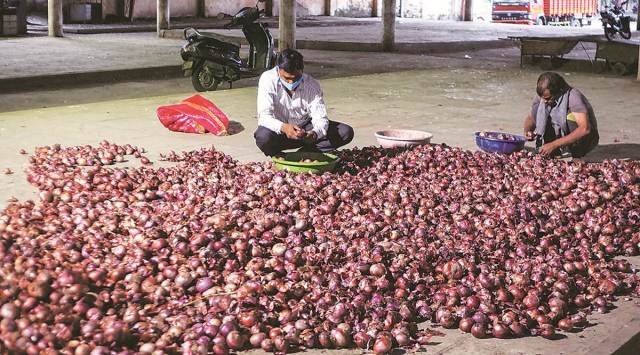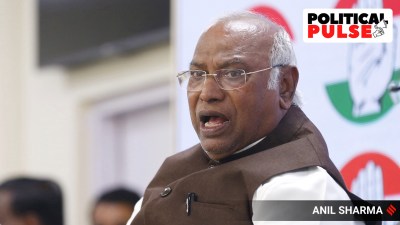- India
- International
Govt imposes stock limits on onion to check prices; traders doubt its impact
The stock limit, which comes into effect immediately, will continue until December 31.
 Nashik is also the centre for large-scale procurement of onions by farmer producer companies (FPC). (File Photo)
Nashik is also the centre for large-scale procurement of onions by farmer producer companies (FPC). (File Photo)With retail prices of onion reaching nearly Rs 100 per kg in some cities, the government on Friday invoked provisions of the Essential Commodities Act, 2020, and imposed onion stock limits of 25 metric tonnes (MT) for wholesalers, and 2 MT for retailers.
The stock limit, which comes into effect immediately, will continue until December 31.
But the decision may not have much effect on prices, according to market sources. Most of the produce is still with farmers, who are in no hurry to liquidate their stock, traders across wholesale markets in Maharashtra said.
“The stock limit is applicable for us, traders. There is no such limit on farmers. And since the next crop is delayed, most are holding on to their stock in the hope of better prices,” said a trader operating out of Lasalgaon’s wholesale market in Maharashtra’s Nashik district.
With the new kharif crop being delayed by several weeks, prices are also unlikely to see a drastic drop in immediate future, they said.

The move comes barely a month after the government amended Essential Commodities Act, 1955, to exclude onions, pulses, potatoes, edible oils and oilseed from the list of essential commodities.
Addressing the media digitally, Consumer Affairs Secretary Leena Nandan said the government had to invoke the Essential Commodities (Amendment) law, which allows it to regulate perishable commodities in an extraordinary situation of price-rise, and called it a “decisive step”.
Under provisions of this law, any action on imposing stock limit will be based on price-rise, and an order for regulating stock limit may be issued only if there is “hundred per cent increase in retail price of horticultural produce; or fifty per cent increase in retail price of non-perishable agricultural foodstuffs”, over the price prevailing immediately preceding 12 months, or average retail price of last five years, whichever is lower.
Exemptions from stock-holding limits will be provided to processors and value chain participants of any agricultural produce, and orders relating to the PDS, the law states.
The Ministry of Consumer Affairs, Food and Public Distribution said in a statement, “The all-India average retail price variation of onions as on 21.10.2020 when compared to last year is 22.12% (from Rs 45.33 to Rs 55.60 per/kg), and when compared to last 5 years average is 114.96% (from Rs 25.87 to 55.60 per/kg). Therefore, prices have increased by more than 100% when compared with the average of the last 5 years and thus the price triggers under EC Act have been reached.”
Retail prices of onion were over Rs 100 per kg in Bengaluru and Puducherry this week.
Earlier this week, the government had relaxed the import norms for onions. It had also said that an estimated kharif crop of 37 LMT is also likely to start arriving in mandis, which will add to the availability of onions.
While the decision on stock limit has evoked strong reactions among farmers and farmers’ leaders, most traders feel this would not see any drastic effect on prices. This summer, farmers in Maharashtra, one of the country’s largest onion-growing states, had stored around 27 lakh tonnes of their summer crop in on-field storage structures, called ‘kanda chawl’. Sources in wholesale markets said that till now farmers have 10 lakh tonnes in storage, which they are selling in tranches.
Lasalgaon, the country’s largest onion market, has reported an average traded price of around Rs 60 to Rs 65 per kg since the last few weeks.
Jaydutt Holkar, director of Mumbai’s wholesale market, was critical of what he called is lack of information about the crop condition. “It started with the ban on exports, then came the I-T raids on traders, and now reintroduction of stock limits,” he said. “This shows the government’s desperation and complete lack of knowledge about the ground situation”
Holkar, who earlier headed the Lasalgaon market, also said the next kharif crop, which was to hit the markets in early-November, will be delayed by the heavy rain in Nashik and other onion-growing regions.
Maharashtra’s former MoS (Agriculture) Sadabhau Khot said the decision has put a question mark on reliability of the government. Khot, whose outfit Rayat Sanghatana is in alliance with the BJP, had earlier welcomed the farm laws.
Meanwhile, imported onions have started trickling in, which the government hopes will help cool down prices. Ajit Shah, president of Onion Exporter Association, confirmed that around 6,000 tonnes of imported onions are expected to arrive in Mumbai in the next fortnight or so.
“The landed price of the imported onions would be between Rs 50-55 per kg. Once this arrives, prices will cool down a bit,” he said.
However, traders said imported onions do not have much acceptance in retail markets and mostly the hotel industry corners them. “Overall, sentiments would remain bullish till the next crop arrives,” said Suresh Deshmukh, a commission agent operating from Dindori’s wholesale market in Nashik district.
Apr 19: Latest News
- 01
- 02
- 03
- 04
- 05







































